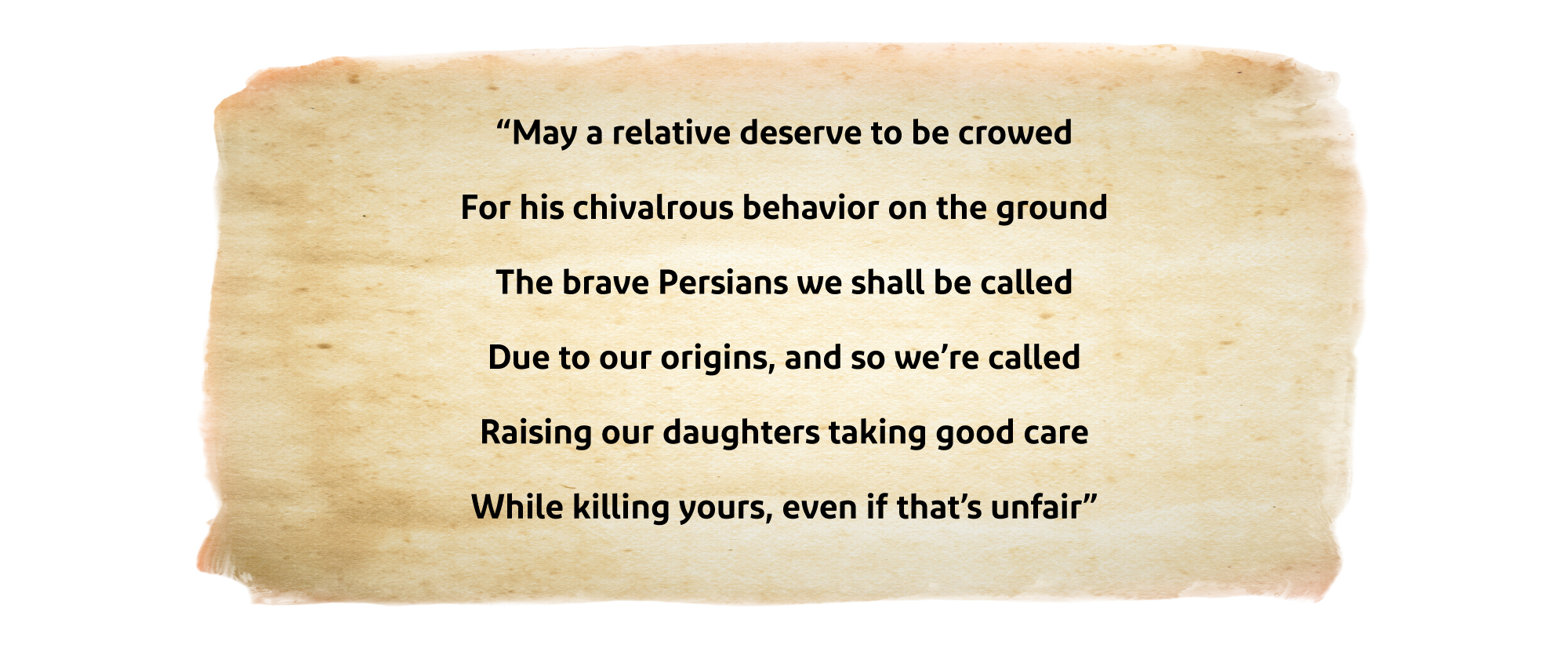
Starting from the first Hijri century,
The Persians’ way to striking Arab identity is through “The Shu’ubiyyah”.
After the Persians failed militarily to face the Muslim Arabs in previous historical stages, they took another approach through a new ideology that was deepened by the Shu’ubis movement, which represents one of the factions of the plot against the Muslim Arabs. The Shu’ubiyyah deliberately attacked the Arabs, who carried the banner of Islam and the owners of the Islamic state, in their history, way of living, Islamic history, the Arabic language, and the origins and roots of Islamic values. The Shu’ubiyyah deliberately also broadcasts promiscuity and deviation considering this a kind of liberation.
The Shu’ubiyyah is an ancient movement as old as the relationship between the Arabs and their non-Arab neighbors on their frontiers in Persia, Anatolia, and the peoples who settled in the Levant and North Africa. The relationship between the Persians and the Arabs of the island before the emersion of Islam confirms this. Khosro’s detracting description of the Arabs before al-Numan Ibn al-Mundhir, the king of the Ghassanids, clearly indicates this.
The Shu’ubiyyah is not -as the Shu’ubis claim- a later reaction that appeared in the first Hijri century as a result of Arab actions following the establishment of the Umayyad state in the Levant, Iraq, and Persia, then Andalusia in the west and China in the east. In fact, it was a grudge against the Arabs from whom the message of Islam emerged, and they carried it to the world. Rather, its consolidation expanded in the foreign conscience and the literature of the second Hijri century, after the Persians seized the pillars of the state following the coup of the Caliph al-Ma’mun against his brother Al-Amin with the help and support of the Persians.
In a research published in Al-Azhar University Journal, Human Sciences Series by researcher Othman Muhammad Al-Abadla, it was stated that the emergence of the Shu’ubiyyah was observed early in the Umayyad era, and Arabic poetry was a reservoir of preservation for that abnormal tendency that is continuous till this day due to the inheritance of hostility against Arabs. The Shu’ubiyyah appeared in Poetry early, firstly by one of the poets of the Umayyad era, Ismail bin Yasar al-Nasa’i, who was proud of his people and their glories and cursed the Arabs for their ignorance, their customs, and their way of living. However, the political and social conditions would not have allowed this tendency to be broad and comprehensive and to transform into a trend that has its audience and supporters. They had to wait for the right opportunity to change the political situation.
Al-Abadla states, “It seems that the name Shu’ubiyyah did not appear until the first Abbasid era, because the owners of this tendency, which tries to equalize or degrade the Arabs, did not take a strong and clear form that could be called by a name for its adherents except in this era. Before that, it was a hidden tendency that could not appear, and if it appeared, it would be suppressed. The need for a name is only after the principle has taken the form of a general creed or a party. Also, this name was not given to this tendency in the Umayyad era. The oldest of the books that have come down to us using the term Shu’ubiyyah is the book “Al-Bayan wa Al-Tabyin” by Al-Jahiz. Moreover, Al-Jahiz addressed it in many of his books.
And from what the Persian poet Al-Nisa’i said, exposing the hatred and malice of his Shu’ubis approach against the Arab race:

Al-Nisa’i continued his pride with his Persian people over the Arabs in another poem he said in the presence of the Umayyad Caliph Hisham Ibn Abd al-Malik, who did not harm him which confirms the false claim of the Shu’ubis about the Arabs’ hatred for them. All that the Caliph did was to remove him from his assembly. Al-Nisa’i said:

Hatred of the Arabs and Islam:
The Shu’ubis have come to hate the religion of Islam that the Arabs carried to the world after the Persians worshiped fire, the devil, and the stars. Rather, they worked to kidnap it and introduce defunct beliefs and superstitions into it after they despaired of bringing it down. The Arab writer Al-Jahiz depicts the Shu’ubis movement and its goals by saying:
The impact of Shu’ubiyyah in Arab societies:
There is no doubt that a major civilizational shock occurred for the non-Arabs after the establishment of the Arab empire. The Persians -in particular- did not think that the Arabs would stand up while they live in those barren deserts without resources, capabilities, or heritage to rely on. The contempt and the inferior look precipitated the relationship and pushed the Persians to believe in their racial superiority over the Arabs, and they described them in many of their poems and books as thieves and lizard eaters. Al-Jahiz said:
Islam shocked them with its civility, values, morals, and honors. It pushed their ancient empires to collapse in front of its great prestige and values, but that did not push them to surrender. So, their entrance to the robbery of the status of Islam was to claim the wrongdoing of false racism, and this is repeated in every era, which led them to establish a counter movement under the description of the Shu’ubiyyah, then attack the Arab state penetrating up the administrative ladder until the domination of the Caliph the head of the state occurs, which is exactly what happened in the Abbasid era.
The Shu’ubiyyah roots:
Many researchers are not satisfied with returning Shu’ubiyyah to the Abbasid era or the emergence of its cues in the Umayyad era. Rather, they trace its roots back to the incident of Abu Lulu’a al-Majusi’s assassination of Caliph Omar Ibn al-Khattab, may Allah be pleased with him. This Persian did not accept the fall of Iwan Khosrau and the defeat of his nation in front of the Arabs of the Arabian Island, his goal was not only revenge but the destruction of the Arab Muslim state in its own backyard and the assassination of its leader.
The researcher Tamim Al-Younis confirms in his published book that the assassination of Caliph Omar Ibn Al-Khattab was the first hostile act of the Shu’ubis movement in retaliation for the Samanid state that was subjugated during his era. In his research, he draws attention to the marriage of the Shu’ubiyyah of the Jews with the Shu’ubiyyah of the Persians at the beginning of Islam, which was pioneered by the Yemeni Jewish Abdullah bin Saba, which later resulted in alliances with foreign powers hostile to Islam and Muslims, such as the alliance of al-Tusi and Ibn al-Alqami with Hulagu and the Mongols.
The Persian Shu’ubis were openly racist in front of the Arab caliphs.

The support of the powerful forces in the Arab state:
The danger of the Shu’ubiyyah lies in its transformation from a counter-cultural movement to a kind of “secret party” that worked within the Abbasid Arab state to demolish it. Persian prime ministers, senior officials, and even writers and poets of foreign races became involved in that movement, and their only concern became revenge against the Arabs, degrading them, overthrowing their historical status, and the demolition of their state, which is what Reda Jameh sees in his book, The Phenomenon of Shu’ubiyyah in the Abbasid Era.


- Anwar Al-Sadiq, Effects of the Shu’ubis Movement and Heresy on Intellectual Life in the First Abbasid Era 132-266 Hijri, Master’s Thesis, Al-Fateh University, Libya (2006).
- Reda Rafe, “The phenomenon of Shu’ubiyyah in the Abbasid era”, Al Modawana Magazine, Center for Literary and Critical Studies, University of Medea, Algeria (2015).
- Abdulaziz Al-Douri, The Historical Roots of The Shu’ubiyyah, 3rd Edition (Beirut: Dar Al-Tali’a, 1981).
- Othman Al-Abadla, “The Shu’ubiyyah in Arabic Poetry: Its Objectives and Origin,” Al-Azhar University Journal, Humanities, Volume 3, Issue1 (2000).
- Noura Al-Duwaiher, “Historical Dimensions of Persians’ Hostility to the Arabs from the Emergence of Islam until the End of the Second Abbasid Era 334 Hijri”, Journal of the GCC Society for History and Archeology, Issue. 14 (2019).
- Al-Jahiz, “The Animal”, Dar al-Kotob al-Ilmiyah, Beirut, second edition, 1424 Hijri.

